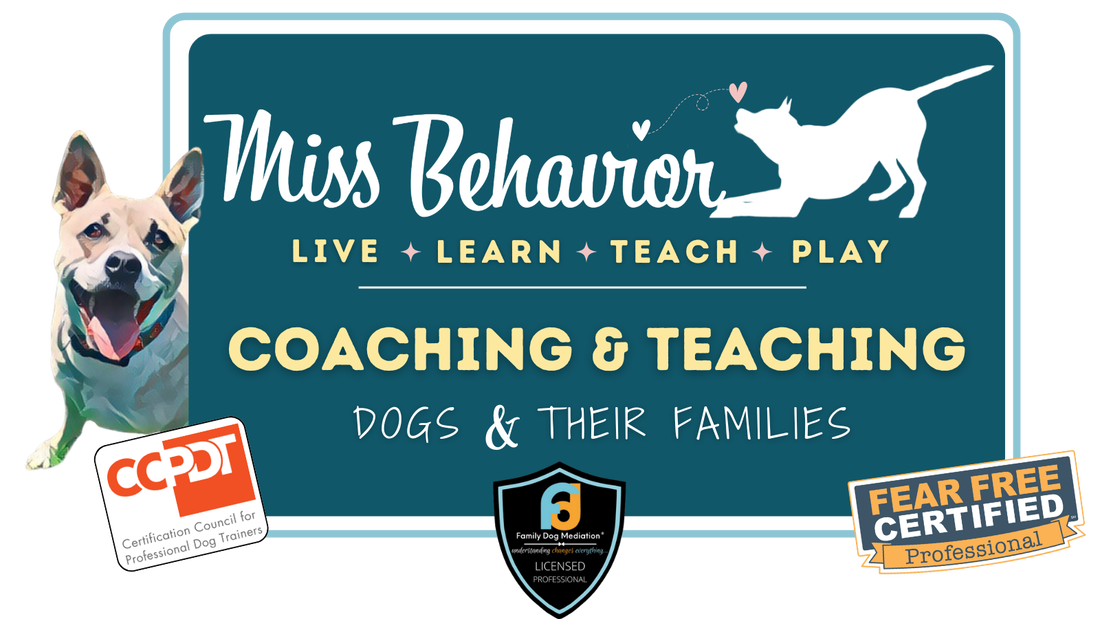|
7 Essential Skill Building Rules for your Family Pup Every new dog skill taught can have many uses as replacements for problem behaviors so whether you're frustrated with your dog and want to teach him something new to replace a "misbehavior" or you want to teach your dog fun tricks for relationship building, there are 7 key rules to keep in mind when teaching your dog anything new! 1. One new skill at a time  Only introduce one new skill per session so you don't confuse or overload your dog. When you try to teach too many new things within a single session, it's easy for them to get lost. It's also easy for us to make small mistakes in the process. 2. Use SHAPING regularly  Shaping is like creating building blocks that form your end goal. There are two main types of shaping. There's free-shaping where you let your dog guide you and you capture the behaviors that you like and want to build on. There's also prompted shaping, where you prompt or lure your dog to perform a specific behavior that you can then build on 3. Easy wins often  Once you've added a few new steps, it's never a bad idea to go back to review the basics. Remember, you need a solid foundation for everything else to build on first! When you teach your dog something basic and then never go back to review it, it can quickly break down in the process and then you can lose everything you've been building 4. Have empathy for the process  Every dog learns differently. It's important to work with the dog in front of you and don't expect him to learn at the same rate or in the same order as another dog might. It's easy to compare your dog to a friend or family member's dog or even a dog you had in the past, but remember... just like people, every dog has it's own individual personality. When you get lost in comparison, you're missing out on the learning process! 5. Don't add the cue at the wrong time  Don't add the cue until you are able to predict the behavior will happen. This will prevent you from cueing the wrong behavior at the wrong time. Wait until your dog can offer the behavior 5 times in a row before inserting the cue into the mix. 6. Keep it light, playful, and fun!  Be sure to reward your dog with treats and play. Nothing about this should feel like work. Your dog will be able to use these skills as replacements for problem behaviors so keep it light and fun! 7. Listen with your eyes  Keep an eye on your dog's body language. Subtle stress signals are part of the learning process but if it's repetitive or your dog is avoidant, take a break and re-assess If you don't know what some of the subtle body signals are (ie yawning or tongue flicking), you can grab my free Body Language Training here Interested in learning more? Check out my Virtual Membership where this is just one of many lessons taught and broken down for you so you can form a less stressful relationship with your family dog!
0 Comments
Your comment will be posted after it is approved.
Leave a Reply. |
|
- Home
- About
- Blog
- Services
- Membership
-
Courses & Freebies
- All Courses
- FREE Boredom Buster Recipes
- COURSE: Building Resilience in your Family Dog
- COURSE: Managing the Leash Walk
- Potty Training COURSE
- Paws Off COURSE
- COURSE: Managing the Leash Walk
- FREE Attention Building Challenge
- FREE Scratchboard Training
- FREE Rest and Recovery Round-Up
- FREE Body Language 101
- Contact
- Home
- About
- Blog
- Services
- Membership
-
Courses & Freebies
- All Courses
- FREE Boredom Buster Recipes
- COURSE: Building Resilience in your Family Dog
- COURSE: Managing the Leash Walk
- Potty Training COURSE
- Paws Off COURSE
- COURSE: Managing the Leash Walk
- FREE Attention Building Challenge
- FREE Scratchboard Training
- FREE Rest and Recovery Round-Up
- FREE Body Language 101
- Contact
Search by typing & pressing enter



 RSS Feed
RSS Feed





